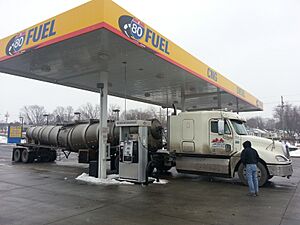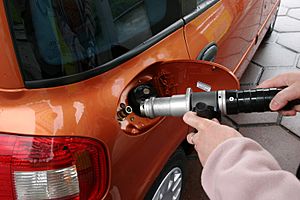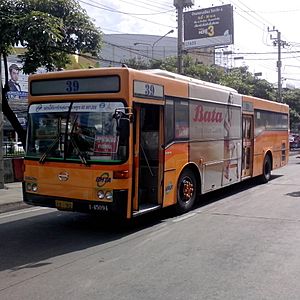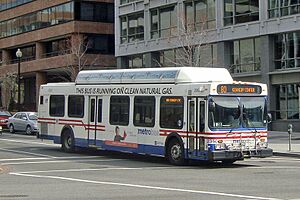Natural gas vehicle facts for kids
A natural gas vehicle (NGV) is a type of car, truck, or bus that uses natural gas instead of gasoline or diesel. Natural gas is a cleaner fuel that can help reduce pollution. These vehicles use either compressed natural gas (CNG) or liquefied natural gas (LNG).
Contents
What is Natural Gas?
Natural gas is a mix of different gases, mostly methane. It's a hydrocarbon, which means it's made of hydrogen and carbon atoms. We often find natural gas deep underground, near where petroleum (oil) is found.
Storing and Moving Natural Gas
Getting natural gas from where it's found to where it's used can be tricky. Pipelines are good for moving it on land, but they can't go across huge oceans. For long distances over water, natural gas is often cooled down to become a liquid.
- Compressed Natural Gas (CNG): This is natural gas stored in strong containers under very high pressure. It's like air in a bicycle tire, but much more compressed.
- Liquefied Natural Gas (LNG): This is natural gas cooled to an extremely low temperature, about -162°C (-260°F). At this cold temperature, the gas turns into a liquid, which takes up much less space.
How Natural Gas is Used
Natural gas is used for many things. A lot of it is burned to make electricity. It's also popular because it creates less pollution than other fossil fuels like coal or oil. A smaller but growing amount is used as fuel for vehicles.
Natural Gas Vehicles: How They Work
A Quick Look at History
The very first gas engine was built by Étienne Lenoir in 1862, even before gasoline or diesel engines became common. Over time, gas technology got better. However, starting in the 1950s, car makers focused more on gasoline engines. For a while, natural gas cars were rare, and there weren't many places to fill them up. But now, because of worries about climate change and the environment, natural gas is becoming important again.
Natural Gas Vehicles Around the World
Today, there are about 5.7 million natural gas vehicles worldwide. Countries like Argentina, Brazil, and Pakistan have a lot of them.
- Europe: Some car companies are working with gas suppliers to make it easier for people to refuel their cars at home. In London, natural gas vehicles don't have to pay city tolls, and their owners pay less tax.
- Asia: In places like Ankara, Turkey, and India, more natural gas vehicles are being used to help reduce pollution. Pakistan has seen a huge increase in these cars, with about 1.4 million on the road.
- America: In Brazil, police departments use many natural gas vehicles. In the United States, using natural gas helps vehicles meet strict clean air standards.
How the Technology Works
Natural gas vehicles come in two main types:
- Bifuel vehicles: These cars can run on either natural gas or gasoline. This gives drivers more options.
- Monofuel vehicles: These cars can only run on natural gas.
The engine in a natural gas vehicle works a lot like a regular gasoline engine. The main difference is that it mixes natural gas with air, instead of gasoline with air, to create power. Many regular cars can even be changed (or converted) to run on natural gas. Car companies are also developing new technologies, like "Turbo natural gas" (TNG), to make these engines even better.
Companies Making NGVs
Many well-known car companies are making vehicles that run on natural gas. Some of them include:
Why Natural Gas Vehicles Are Good
One big advantage of natural gas is that it's often cheaper than gasoline or diesel. Also, in many places, there's a lower tax on natural gas used for vehicles. This can save drivers money.
Where to Fill Up
The number of natural gas filling stations is growing steadily. For example, in Germany, there were 771 natural gas stations in January 2008, and more are being built, especially near major roads.
The Future of Natural Gas Vehicles
Natural gas technology has been around for a long time and is becoming more popular. While natural gas is a finite resource (meaning there's a limited amount of it), it's a cleaner option than other fossil fuels for now. As technology improves, we will likely see even more efficient and environmentally friendly ways to power our vehicles in the future.
Images for kids
-
A Brazilian flexible-fuel taxi that can also run on natural gas.
-
The Brazilian Fiat Siena Tetrafuel, a car popular with taxi drivers, can run on four different fuels, including natural gas.
See also
 In Spanish: Gas natural vehicular para niños
In Spanish: Gas natural vehicular para niños



















